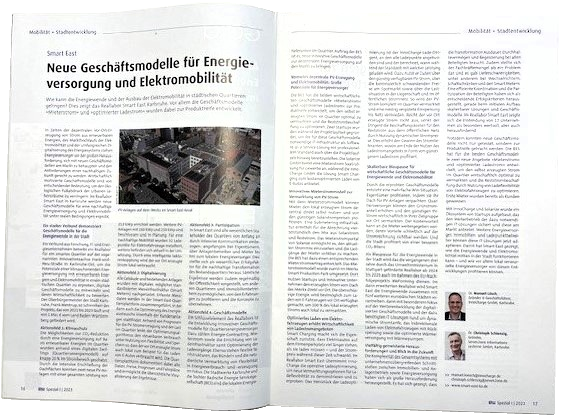In the special 2023 issue of ew – Magazin für Energiewirtschaft (ew – Magazine for the energy industry) on the topic of “Stadtwerke der Zukunft” (municipal utilities of the future), we provide insights into the transformation of the Smart East commercial district in the eastern part of Karlsruhe into a climate-friendly district with 620 kWp photovoltaics and optimized e-mobility with 50 charging points. Using the case study as an example, we explain how real estate operators and energy suppliers can benefit from the tried-and-tested overall solution for sustainable and cost-effective e-mobility – and how they can assert themselves in the new market environment with sustainable and in-demand business models.
Rising demand in commercial properties for charging infrastructure and on-site photovoltaics
In times of decentralized on-site generation of renewable energies, the market ramp-up of electromobility and the extensive digitalization of the energy system, property operators and energy suppliers are facing major challenges. They have to assert themselves on the market with new business models and meet the requirements of a sustainable future. Economically motivated business models are also crucial for reducing the ecological footprint of urban living spaces.
Optimized charging of electric vehicles increases the profitability of charging offers
Smart charging makes use of the fact that electric cars are parked in company parking lots for much longer than they need to be charged – and the price of electricity fluctuates during this time. In the Smart East real-world laboratory, lnnoCharge is responsible for operational charging optimization in order to demonstrate and test new marketing options for charging flexibility. The heart of the charging optimization is the lnnoCharge charging conductor, to which all charging points are connected and which calculates when to charge and at what power during the downtime. To do this, it uses data on the cheaply available PV electricity, the continuously fluctuating prices on the spot market and the load situation in the property and in the public electricity grid. In the district under consideration, the PV electricity is thus marketed entirely in the district and a low-remunerated feed-in to the grid is avoided. If the electricity generated on site is not sufficient, the conductor reduces the procurement costs for the remaining electricity from the public grid by using dynamic electricity prices. This increases the profit of the electricity supplier or charging point operator, which ultimately benefits the user of the charging power supply in the form of cheaper charging power.
Scalable blueprint for economic business models for the energy transition and e-mobility
The article shows how the two tried-and-tested business models for optimized charging current and photovoltaic tenant electricity create a multiple win situation: owners benefit by leasing their roof for PV systems. Neighborhood suppliers can increase the proportion of green electricity and market the low-cost PV electricity economically to their target group locally. The cost advantage can be passed on to the tenants, whose benefits are ultimately visible on the electricity bill. And the city benefits from a better CO2 balance.

